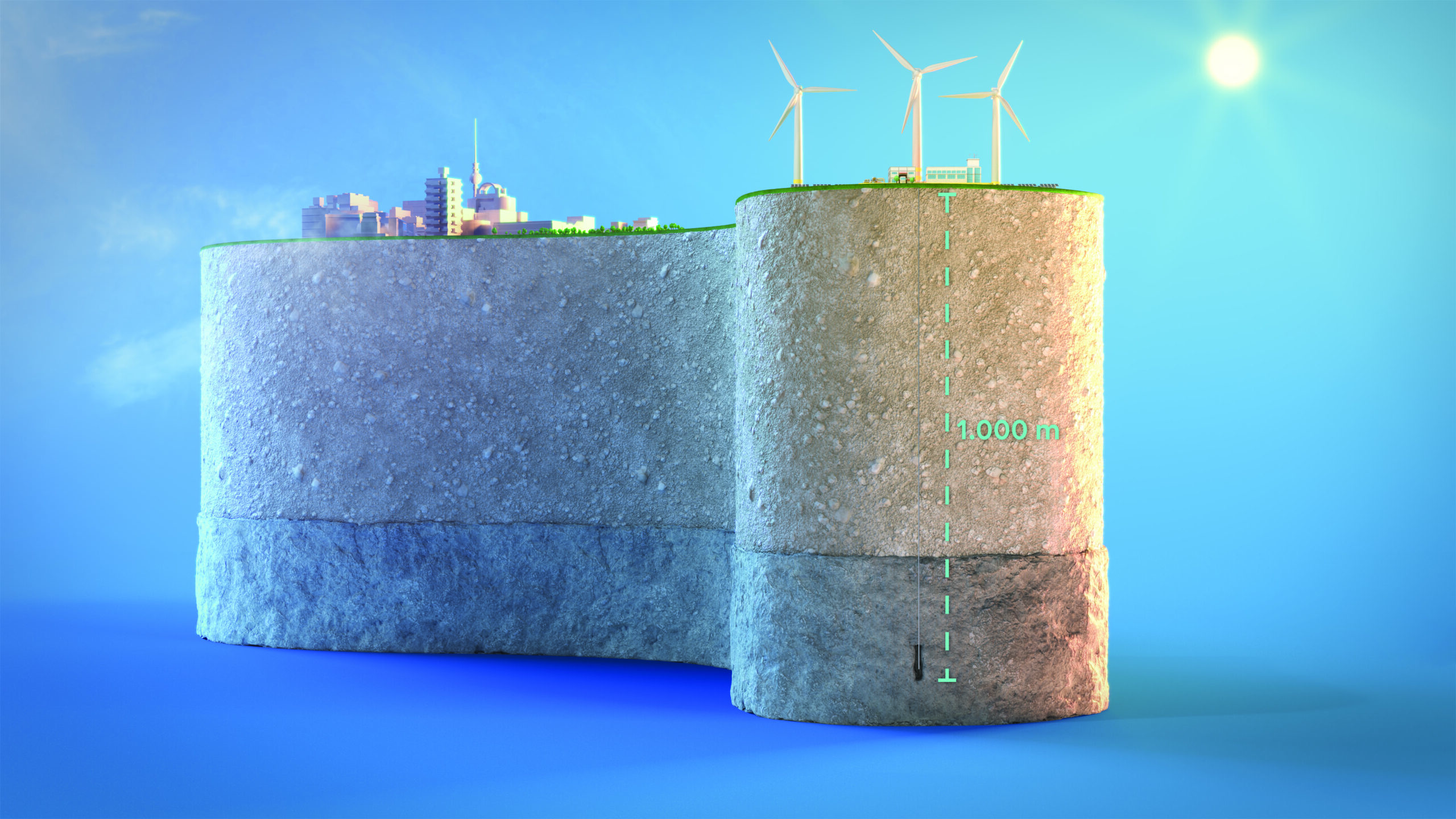PROJEKTE
 Quelle: EWE
Quelle: EWE
©EWE/C3 Visual Lab
HyCAVmobil (Hydrogen Cavern for Mobility) – Untersuchung von Salzkavernen als potenziellen Speicherort für Wasserstoff
News (17.05.2024): Erster Testbetrieb der EWE-Wasserstoffkaverne in Rüdersdorf erfolgreich abgeschlossen
Die EWE AG hat am Freitag bekanntgegeben, dass der erste Testbetrieb seiner 500 Kubikmeter großen Wasserstoffkaverne im brandenburgischen Rüdersdorf erfolgreich abgeschlossen wurde.
Im Rahmen des Projekts „HyCAVmobil“ wurde der erste Test zum Ein- und Ausspeichern von Wasserstoff erfolgreich abgeschlossen – das Ergebnis der langsamen Betriebsfahrweise sei laut EWE zufriedenstellend. Auch die Qualität des Wasserstoffs war zufriedenstellend: „In unserem ersten Betriebszyklus hat sich die Qualität des Wasserstoffs nach Ausspeicherung nur wenig verändert“, heißt es von EWE.
News (20.10.2023): Wasserstoffeinlagerung beginnt
EWE startet mit der Einlagerung von Wasserstoff. Die Wasserstoff-Befüllung erfolgt an acht Tagen rund um die Uhr mit Hilfe eines rollierenden Anlieferungsprozesses mit insgesamt sechs Tankfahrzeugen. Durch die kontinuierliche Befüllung wird die Sole, die sich vom Bau des Hohlraums noch in der Kaverne befindet, gleichmäßig verdrängt und an die Erdoberfläche gebracht. Diese 500 Kubikmeter wässrige Lösung transportiert EWE über eine vorhandene Soletransportleitung zur Soleversenkstation nach Heckelberg. Dort sind die Gesteinsschichten für die Versenkung von Sole, einem Gemisch aus Salz und Wasser, geeignet.
Nach der Wasserstoff-Befüllung beginnt der umfangreiche Testbetrieb und die Forschungen im Rahmen des Vorhabens mit dem Namen „HyCAVmobil“. Dabei wird vor allem das Wechselspiel zwischen der Ein- und Ausspeicherung von Wasserstoff getestet.
Im Rahmen der Tests erhält EWE auch erstmals unterirdische Livedaten von Temperaturen und Drücken für die Auswertung des Ein- und Ausspeicherprocederes. Möglich wird dies durch ein Glasfaserkabel und Drucksensoren, die EWE bei der Kavernenerrichtung mit eingebaut hat. Durch diese digitale Anbindung sind EWE zufolge kontinuierliche Messungen in der Kaverne möglich.
Parallel zu den Vor-Ort-Tests in Rüdersdorf startet das Institut für Vernetzte Energiesysteme des Deutschen Zentrums für Luft und Raumfahrt (DLR) mit der Untersuchung der Qualität des Wasserstoffs im Labor. Die Gasproben werden sowohl vor der Befüllung der Kaverne als auch während des Betriebs entnommen und hinsichtlich der Gasreinheit analysiert. Eine Untersuchung der Sole soll Rückschlüsse über den möglichen mikrobiellen Einfluss auf die Wasserstoffqualität geben. Die Ergebnisse fließen in die Bewertung ein, ob der gespeicherte Wasserstoff direkt für den Einsatz in Brennstoffzellenfahrzeugen geeignet ist oder ob für diese oder andere Anwendungen eine Reinigung nach der Ausspeicherung erforderlich ist.
Die Tests dauern etwa ein Jahr, bevor die Ergebnisse für die großtechnische Speicherung, beispielweise am Standort Huntorf in Niedersachsen, insgesamt ausgewertet und übertragen werden können.
News (26.05.2023): Projekt zur Wasserstoff-Speicherung erreicht nächste Phase: H2dry Anlage von Bilfinger wird am EWE Gasspeicher-Standort in Rüdersdorf aufgebaut
Bilfinger hat in Cloppenburg eine Demonstrationsanlage entwickelt, in welcher der Wasserstoff durch Absorption von Feuchtigkeit befreit wird.
Die sogenannte „H2dry Anlage“ wurde nun zum Gasspeicherstandort der EWE AG nach Rüdersdorf bei Berlin geliefert, wo die Speicherung von Wasserstoff in unterirdischen Kavernen exemplarisch getestet wird. Die Erkenntnisse sollen auf Kavernen mit dem 1.000 fachen Volumen übertragen werden können. Mehr erfahren
News (13.03.2023): EWE stellt Wasserstoff-Testkaverne fertig und will im Spätsommer mit der Wasserstoffeinlagerung beginnen!
Wie EWE in der vergangenen Woche bekanntgegeben hat, ist die Wasserstoff-Testkaverne in Rüdersorf bei Berlin erfolgreich fertiggestellt worden. In den vergangenen drei Monaten wurde ein unterirdischer Hohlraum mit etwa 500 Kubikmetern Volumen geschaffen und verschiedene Dichtheitstests erfolgreich umgesetzt worden. Die Erstbefüllung mit Wasserstoff und der umfangreiche Testbetrieb der Kaverne sind für den Spätsommer dieses Jahres geplant. Das Projekt mit dem Namen „HyCAVmobil“ soll wichtige Erkenntnisse liefern, die auch auf größere Kavernen mit dem 1.000-fachen Volumen, wie sie z.B. in Niedersachsen existieren, übertragen werden können. Hierdurch soll schließlich die großtechnische Wasserstoffspeicherung ermöglich werden.
Mehr erfahren: https://www.ewe.com/de/media-center/pressemitteilungen/2023/03/wasserstoffkaverne-ist-fertiggestellt-ewe-ag
Für eine zuverlässige Versorgung mit sauberem Wasserstoff, muss eine ganzheitliche Infrastruktur, wie auch bei fossilen Gasen, aufgebaut werden. Neben dem Netzausbau bzw. -umbau gehört dazu auch die Speicherung des Gases. Wie wir Wasserstoff langfristig und zuverlässig lagern können, wird zunehmend wichtiger für die Sektorenkopplung.
Das Projekt HyCAVmobil der EWE Gasspeicher GmbH und des Deutschen Zentrums für Luft- und Raumfahrt (DLR) Institut für vernetzte Energiesysteme beschäftigt sich deshalb mit der nachhaltigen und sicheren Speicherung von 100 Prozent reinem Wasserstoff in Salzkavernen – ein Vorreiterprojekt.
Aktuell dienen Salzkavernen als sichere Langzeitspeicher für Energieträger wie etwa Erdgas oder Erdöl. Im Rahmen der Energiewende wird diese Art der Speicherung nun auch für Wasserstoff in Betracht gezogen. Um Wasserstoff langfristig zu speichern und anschließend im Bereich der Brennstoffzellenmobilität zu nutzen, soll im Projekt HyCAVmobil (Hydrogen Cavern for Mobility) erforscht werden, unter welchen Bedingungen sich auch reiner Wasserstoff in Salzkavernen einlagern lässt. Das Hauptaugenmerk liegt darauf, wie sich die Ein- und Auslagerung auf die Qualität des Wasserstoffs auswirken.
Nach ersten Untersuchungen im Labormaßstab baut EWE gemeinsam mit seinem niedersächsischen Projektpartner seit Februar 2021 im brandenburgischen Rüdersdorf einen unterirdischen Kavernenspeicher. In einem ersten Schritt wird ein Bohrturm errichtet und der Salzstock in 1.000 Metern Tiefe mit Wasser ausgespült. So entsteht ein Hohlraum von 500 Kubikmetern, in dem künftig bis zu sechs Tonnen Wasserstoff eingelagert werden sollen. Zur Veranschaulichung: Diese Menge reicht, um rund 1.000 Wasserstoff-PKW vollzutanken. Wenn das Projekt erfolgreich sein sollte, lassen sich die Erkenntnisse dieses Projekts problemlos auf Kavernen mit dem 1.000-fachen Volumen übertragen, so die Verantwortlichen. Das wäre ein wichtiger Schritt hin zur großtechnischen Wasserstoffnutzung.
Das Projekt wird im Rahmen des Nationalen Innovationsprogramms Wasserstoff- und Brennstoffzellentechnologie gefördert und erhält einen Förderzuschuss des Bundesministeriums für Verkehr und digitale Infrastruktur (BMVI) in Höhe von rund 6 Millionen Euro.
Partner
Mit rund 9.100 Mitarbeiterinnen und Mitarbeitern ist die EWE AG eines der größten Versorgungsunternehmen Deutschlands, das sich im Bereich Wasserstoff auf entsprechende Infrastruktur fokussiert.
Logo: © EWE AG
Das Oldenburger Institut für Vernetzte Energiesysteme entwickelt Technologien und Konzepte für die zukünftige Energieversorgung auf Basis erneuerbarer Energien. Dieser Transformationsprozess wird unter Berücksichtigung der Aspekte „Defossilierung“, „Dezentralisierung“ und „Digitalisierung“ erforscht.
Logo: © DLR Institut für Vernetzte Energiesysteme
Bleiben Sie informiert – mit unserem Newsletter „NWN direkt…“
Sie möchten über diese und andere spannende Wasserstoff-Projekte aus Niedersachsen informiert bleiben? Dann melden Sie sich bei unserem Newsletter an!



